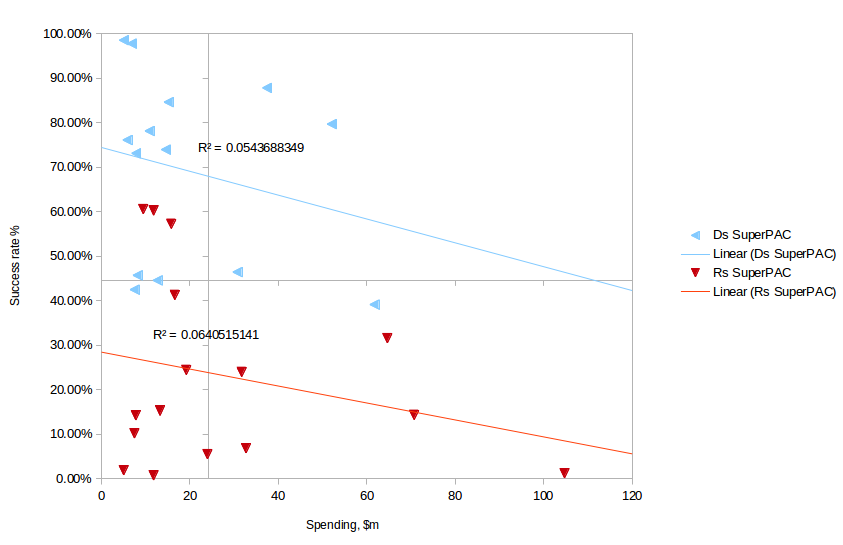So I picked a fight with Tom Lee of Sunlight Labs about why a rather good piece on whether the big spenders in US politics actually achieved anything with their money didn’t have any charts.
Sunlight reckons campaign money was surprisingly ineffective, and Republicans had the most of it, in a post that surely does have plenty of charts. Let’s link the two. I pulled out the information on the size of the SuperPACs and their effectiveness into a spreadsheet, cleaned up the usual tiresomeness, did an X/Y plot, and added a linear trendline (having tried other curve-fitting options). I then broke out the PACs by partisan affiliation, and created trend lines for each group. The groups are coloured by party, following the usual (weird) US convention.
Then I set the axes to cross at the mean values for each axis, converting the chart into a 2×2 matrix. I can’t help it – I learned this stuff from ex-Bain consultants, and one thing working with Bain people teaches you is that everything in the world is a 2×2 matrix.
Upshot. The Democrats, overall did far better. In my 2×2, the top-right hand quadrant is where you ideally want to be – both big, and effective. The only SuperPACs that got into that quadrant were Democratic ones. By contrast, in the dog shit zone of the lower right quadrant – big, and useless – there are Republicans, with one exception, and serious Republicans at that. Karl Rove’s mega-PACs are all in there and so is the NRCC, the NRSC, and the US Chamber of Commerce.
Most Democratic SuperPACs ended up in the top-left quadrant, characterised by relatively small funds and very effective targeting. Trade unions and feminists appear to have a special knack. Women Vote!, two Planned Parenthood PACs, two Service Employees’ International Union PACs, and Workers’ Voice are way up there, as is the green League of Conservation Votes.
Republican organisations were mostly around the boundary between the lower left and lower right quadrant – a.k.a the zone of mediocrity.
There was a weak inverse relationship between size and effectiveness overall (R2 = 0.08). It was very slightly stronger for Democratic groups than Republicans, but the effect is very far from statistically significant.
The only Democratic group that fell into the “big, but useless” category was the National Democratic Congressional Committee. This illuminates a problem. It was a good day to be a Senate Democrat. It was a good day to be a Democratic president. It wasn’t such a good day to be a House Democrat. Isn’t the causality that way round? Well, if it was, you’d expect the Republican Congressional Committee to do better than the equivalent D committee, and they didn’t. NDCC, although it was in the dog shit quadrant, was almost 10 percentage points better on effectiveness than NRCC, and was comparable in size. It would need to improve its hit rate by only 5 points to make it into the top-performance group.
OK, so it’s time for Jerry’s Final Thought. The Republicans had the most money. They pissed it up the wall. This may explain why money didn’t seem to be very effective overall.
What else? Karl Rove lost personally, badly. His monster funds account for most of the apparent negative correlation between size and effectiveness all by themselves. Grover Norquist’s Americans for Tax Reform got into the half-decent group, although the Democratic funds in that group outdid him. As a rule, the unions and the women are great, but we knew that.
NDCC needs fixing. It only needs to improve by 5 percentage points to be a top-performer, and it’s almost as big as Rove’s Crossroads-GPS, so it’s worth doing.
Republicans, for their part, need to kick out the hucksters and the extremists. Well, good luck with that, looking at this superb Rick Pearlstein piece, and you have to wonder if the treatment would kill the host.
Update: Check out this story on the Republicans’ shitty polling. Not only does it reflect the general air of bungling stupidity and massive groupthink, it also points out that the NRSC’s polls were especially dreadful. The NRSC is one of the lower-right quadrant failsters.
Update Update: Starting out with this, I thought I would find a strong inverse correlation between size and effectiveness, and a tendency for Republican PACs to be bigger. What I found was, instead, that apart from the huge Rove funds, it is competence that divides the parties. Typical funds on either side were of comparable size, but the impact achieved was very different.

I think there are interesting questions for Peter Kellner and his faction in the Republican polling story. While the Republican pollsters most egregiously messed up their screens, many other pollsters were worried that “2008 was an anomaly, we won’t see that kind of Democrat Voter self-identification again.”
In effect, the Republicans were operating on the Kellner principle, that people stay the same and you go to them. Obama was a one off as “first black president” – but it turns out that actually people changed their stance towards issues. So contra-Kellner, perhaps the secret to British politics for the Labour party isn’t “become the Conservative party” but persuade the people that left of centre policies might be a good idea.
I wouldn’t be at all surprised if all the community-team get out the vote stuff has an effect here. I would think you’d be much more likely to identify as a D if you’ve actually been out on the trail yourself. That is the point, after all.
Mind you, it didn’t help the Lib Dems much in my case:-)
Permalink